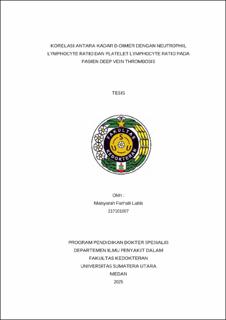| dc.contributor.advisor | Syahrini, Heny | |
| dc.contributor.advisor | Gatot, Dairion | |
| dc.contributor.author | Lubis, Maisyarah Farhati | |
| dc.date.accessioned | 2025-04-09T01:26:55Z | |
| dc.date.available | 2025-04-09T01:26:55Z | |
| dc.date.issued | 2025 | |
| dc.identifier.uri | https://repositori.usu.ac.id/handle/123456789/102711 | |
| dc.description.abstract | Introduction: Venous thromboembolism is a vascular disease that causes deep vein thrombosis (DVT) and pulmonary embolism (PE). The occurrence of DVT is associated with the activation of coagulation factors, which can be accelerated by inflammatory mediators in the microenvironment, and is associated with impaired fibrinolysis processes that produce degradation products, namely d-dimer. D-dimer examination has a negative predictive value (NPV) so it can be used as a screening tool for patients at risk of thromboembolism. Neutrophil-lymphocyte ratio (NLR) examination is a parameter to evaluate chronic inflammation based on total neutrophils and lymphocytes. Platelet-lymphocyte ratio (PLR) is the ratio of the number of platelets to lymphocytes obtained from the same blood sample as an inflammatory marker. NLR and PLR can be easily found through complete blood tests to reflect hemostasis and inflammation that can detect DVT. This study aims to evaluate the correlation between d-dimer levels with NLR and PLR in DVT patients at Adam Malik Hospital.
Methods: This study is an observational analytic study with a cross-sectional method. Secondary data from medical records of patients diagnosed with DVT at Adam Malik Hospital in the period June 2022 to June 2024. The independent variables are NLR and PLR. The dependent variable is d-dimer in DVT patients. Data analysis was performed using statistical tests with Spearman rho test analysis.
Results: From 100 samples obtained, the majority of patients were aged > 59 years (38%), the proportion of gender is perfectly balanced between male and female, patients with the most comorbid infections (71%), the majority of patients' length of hospitalization > 7 days (62%). Bivariate analysis showed that d-dimer was significantly correlated with NLR (p = 0.001, r = +0.350) and however d-dimer was not correlated with PLR (p = 0.610, r = -0.052).
Conclusion: There is a significant correlation between d-dimer and NLR but there is no correlation between d-dimer and PLR in DVT patients at Adam Malik Hospital | en_US |
| dc.language.iso | id | en_US |
| dc.publisher | Universitas Sumatera Utara | en_US |
| dc.subject | Deep Vein Thrombosis | en_US |
| dc.subject | D-dimer | en_US |
| dc.subject | NLR | en_US |
| dc.subject | PLR | en_US |
| dc.title | Korelasi Antara Kadar D-Dimer dengan Neutrophil Lymphocyte Ratio dan Platelet Lymphocyte Ratio Pada Pasien Deep Vein Thrombosis | en_US |
| dc.title.alternative | Correlation Between D-Dimer Levels with Neutrophil Lymphocyte Ratio and Platelet Lymphocyte Ratio in Deep Vein Thrombosis Patients | en_US |
| dc.type | Thesis | en_US |
| dc.identifier.nim | NIM217101007 | |
| dc.identifier.nidn | NIDN0027018001 | |
| dc.identifier.nidn | NIDN0002036205 | |
| dc.identifier.kodeprodi | KODEPRODI11702#Ilmu Penyakit Dalam | |
| dc.description.pages | 80 Pages | en_US |
| dc.description.type | Tesis Magister | en_US |
| dc.subject.sdgs | SDGs 3. Good Health And Well Being | en_US |


